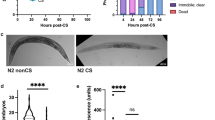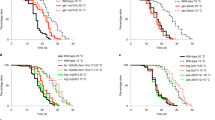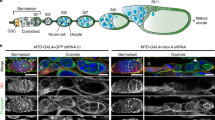Abstract
In 1893 August Weismann proposed that information about the environment could not pass from somatic cells to germ cells1, a hypothesis now known as the Weismann barrier. However, recent studies have indicated that parental exposure to environmental stress can modify progeny physiology2,3,4,5,6,7 and that parental stress can contribute to progeny disorders8. The mechanisms regulating these phenomena are poorly understood. We report that the nematode Caenorhabditis elegans can protect itself from osmotic stress by entering a state of arrested development and can protect its progeny from osmotic stress by increasing the expression of the glycerol biosynthetic enzyme GPDH-2 in progeny. Both of these protective mechanisms are regulated by insulin-like signalling: insulin-like signalling to the intestine regulates developmental arrest, while insulin-like signalling to the maternal germline regulates glycerol metabolism in progeny. Thus, there is a heritable link between insulin-like signalling to the maternal germline and progeny metabolism and gene expression. We speculate that analogous modulation of insulin-like signalling to the germline is responsible for effects of the maternal environment on human diseases that involve insulin signalling, such as obesity and type-2 diabetes8.
This is a preview of subscription content, access via your institution
Access options
Access Nature and 54 other Nature Portfolio journals
Get Nature+, our best-value online-access subscription
$29.99 / 30 days
cancel any time
Subscribe to this journal
Receive 12 print issues and online access
$209.00 per year
only $17.42 per issue
Buy this article
- Purchase on Springer Link
- Instant access to full article PDF
Prices may be subject to local taxes which are calculated during checkout




Similar content being viewed by others
References
Weismann, A. The Germ-plasm: A Theory of Heredity (Charles Scribner’s Sons, 1893).
Dantzer, B. et al. Density triggers maternal hormones that increase adaptive offspring growth in a wild mammal. Science 340, 1215–1217 (2013).
Radford, E. J. et al. In utero undernourishment perturbs the adult sperm methylome and intergenerational metabolism. Science 345, https://doi.org/10.1126/science.1255903 (2014).
Dias, B. G. & Ressler, K. J. Parental olfactory experience influences behavior and neural structure in subsequent generations. Nat. Neurosci. 17, 89–96 (2014).
Öst, A. et al. Paternal diet defines offspring chromatin state and intergenerational obesity. Cell 159, 1352–1364 (2014).
Carone, B. R. et al. Paternally induced transgenerational environmental reprogramming of metabolic gene expression in mammals. Cell 143, 1084–1096 (2010).
Huypens, P. et al. Epigenetic germline inheritance of diet-induced obesity and insulin resistance. Nat. Genet. 48, 497–499 (2016).
Gallo, L., Tran, M., Master, J., Moritz, K. & Wlodek, M. Maternal adaptations and inheritance in the transgenerational programming of adult disease. Cell Tissue Res. 349, 863–880 (2012).
Frazier III, H. N. & Roth, M. B. Adaptive sugar provisioning controls survival of C. elegans embryos in adverse environments. Curr. Biol. 19, 859–863 (2009).
Baugh, L. R. & Sternberg, P. W. DAF-16/FOXO regulates transcription of cki-1/Cip/Kip and repression of lin-4 during C. elegans L1 arrest. Curr. Biol. 16, 780–785 (2006).
Hu, P. J. Dauer 1–19 (WormBook, 2007); https://doi.org/10.1895/wormbook.1.144.1
Murphy, C. & Hu, P. J. Insulin/insulin-like Growth Factor Signaling in C. elegans (WormBook, 2013); https://doi.org/10.1895/wormbook.1.164.1
An, J. H. & Blackwell, T. K. SKN-1 links C. elegans mesendodermal specification to a conserved oxidative stress response. Genes Dev. 17, 1882–1893 (2003).
Kim, D. H. et al. A conserved p38 MAP kinase pathway in Caenorhabditis elegans innate immunity. Science 297, 623–626 (2002).
Chen, Y. & Baugh, L. R. ins-4 and daf-28 function redundantly to regulate C. elegans L1 arrest. Dev. Biol. 394, 314–326 (2014).
Lamitina, S. T., Morrison, R., Moeckel, G. W. & Strange, K. Adaptation of the nematode Caenorhabditis elegans to extreme osmotic stress. Am. J. Physiol. 286, C785–C791 (2004).
Lamitina, T., Huang, C. G. & Strange, K. Genome-wide RNAi screening identifies protein damage as a regulator of osmoprotective gene expression. Proc. Natl Acad. Sci. USA 103, 12173–12178 (2006).
Michaelson, D., Korta, D. Z., Capua, Y. & Hubbard, E. J. A. Insulin signaling promotes germline proliferation in C. elegans. Development 137, 671–680 (2010).
Lopez III, A. L. et al. DAF-2 and ERK couple nutrient availability to meiotic progression during Caenorhabditis elegans oogenesis. Dev. Cell 27, 227–240 (2013).
Sundaram, M. V. RTK/Ras/MAPK Signaling (WormBook, 2006); https://dx.doi.org/10.1895/wormbook.1.80.1
Favata, M. F. et al. Identification of a novel inhibitor of mitogen-activated protein kinase kinase. J. Biol. Chem. 273, 18623–18632 (1998).
Pilson, E. Q. M. An Introduction to the Chemistry of the Sea 2nd edn, 67 (Cambridge Univ. Press, 2013).
Prada, J. A. & Tsang, R. C. Biological mechanisms of environmentally induced causes of IUGR. Eur. J. Clin. Nutr. 52, S21-7-28 (1998).
Brenner, S. The genetics of Caenorhabditis elegans. Genetics 77, 71–94 (1974).
Arur, S. et al. MPK-1 ERK controls membrane organization in C. elegans oogenesis via a sex-determination module. Dev. Cell 20, 677–688 (2011).
Arur, S. et al. Multiple ERK substrates execute single biological processes in Caenorhabditis elegans germ-line development. Proc. Natl Acad. Sci. USA 106, 4776–4781 (2009).
Lee, M.-H. et al. Multiple functions and dynamic activation of MPK-1 extracellular signal-regulated kinase signalling in Caenorhabditis elegans germline development. Genetics 177, 2039–2062 (2007).
Quinlan, A. R. BEDTools: the Swiss-army tool for genome feature analysis. Curr. Protoc. Bioinformatics 47, 11.12.1–11.12.34 (2014).
Li, H. & Durbin, R. Fast and accurate short read alignment with Burrows-Wheeler transform. Bioinformatics 25, 1754–1760 (2009).
Li, B. & Dewey, C. N. RSEM: accurate transcript quantification from RNA-Seq data with or without a reference genome. BMC Bioinformatics 12, 323 (2011).
Karolchik, D. et al. The UCSC Table Browser data retrieval tool. Nucleic Acids Res. 32, D493–D496 (2004).
Anders, S. & Huber, W. Differential expression analysis for sequence count data. Genome Biol. 11, R106 (2010).
Birsoy, K. et al. An essential role of the mitochondrial electron transport chain in cell proliferation is to enable aspartate synthesis. Cell 162, 540–551 (2015).
Acknowledgements
We thank E. J. Hubbard, K. Ashrafi, S. Mitani and the Caenorhabditis Genetic Center, which is funded by the NIH National Center for Research Resources (NCRR), for providing strains; N. An for strain management; and K. Burkhart, S. Luo, A. Doi, N. Paquin and A. Corrionero for helpful discussions. H.R.H. and N.O.B. were supported by NIH grant GM024663 and NSF grant 1122374. T.F. and S.A. were supported by NIH grant GM98200 and ACS grant RSG014-044-DDC. L.R.B., A.K.W. and R.E.W.K. were supported by NIH grant GM117408. H.R.H. is an investigator of the Howard Hughes Medical Institute.
Author information
Authors and Affiliations
Contributions
N.O.B., T.F., A.K.W., R.E.W.K., S.A., L.R.B. and H.R.H. designed the experiments and analysed the data. N.O.B., T.F., A.K.W., R.E.W.K. and S.A. performed the experiments. N.O.B. and H.R.H. wrote the manuscript.
Corresponding author
Ethics declarations
Competing interests
The authors declare no competing financial interests.
Integrated supplementary information
Supplementary Figure 1 C. elegans arrests development in response to osmotic stress.
(a) Representative images of wild-type animals after 72 h of exposure to 50 mM or 500 mM NaCl. Experiment replicated 12 times Scale bar 200 μm. (b) Percent of wild-type animals developing past the L1 larval stage after 24 h of exposure to 50 mM NaCl and 450 mM KCl. Error bars, s.d. n = 3 experiments of >100 animals. (c) Percent of wild-type animals developing past the L1 larval stage after 24 h of exposure to 50 mM NaCl and 450 mM NaBr. Error bars, s.d. n = 3 experiments of >100 animals. (d) Percent of wild-type animals developing past the L1 larval stage after 24 h of exposure to 50 mM NaCl and 900 mM sucrose. Sucrose was added at twice the concentration of salts to compensate for the difference in osmolarity. Error bars, s.d. n = 3 experiments of >100 animals. (e) Percent of wild-type, pmk-1(km25), or skn-1(zu67) animals developing past the L1 larval stage after 48 h of exposure to 300 mM NaCl. Error bars, s.d. n = 3 experiments of >100 animals. (f) Percent of wild-type, pmk-1(km25), or skn-1(zu67) animals failing to arrest development at 500 mM NaCl after 48 h. Error bars, s.d. n = 3 experiments of >100 animals. (g) Percent of wild-type and unc-31(ft1) animals failing to arrest development after 48 h. The osm-6 promoter was used to drive the expression of UNC-31 specifically in sensory neurons. Error bars, s.d. n = 3 experiments of >100 animals. (h) Percent of wild-type and ins-3(tm3608) mutant animals failing to arrest development at 400 mM NaCl after 48 h. Error bars, s.d. n = 3 experiments of >100 animals. (i) Percent of wild-type, ins-3(ok2488), ins-3(ok2488);daf-2(e1370) and rescue animals failing to arrest development at 400 mM NaCl 48 h post-hatching. Error bars, s.d. n = 3 experiments of >100 animals. The variation between the wild type in panels (a) and (b) is likely to be a result of variations in evaporation between different batches of Petri plates. The quantified results are presented as mean ± s.d. using two-tailed t-test. ∗P < 0.05, ∗∗P < 0.01, ∗∗∗P < 0.001, ∗∗∗∗P < 0.0001 were considered significant. n.s., not significant. See Statistics Source Data in Supplementary Table 6.
Supplementary Figure 2 Comparison of gene expression in response to osmotic stress and starvation.
(a) Venn-diagram of genes that exhibit statistically significant changes in gene expression in response to osmotic stress and starvation. (b) Scatter plot of gene expression changes for 1605 genes whose expression is regulated by both osmotic stress and starvation.
Supplementary Figure 3 Insulin-like signalling to the germline regulates developmental arrest in response to osmotic stress.
Percent of wild-type and gpdh-1(ok1558); gpdh-2(ok1733) animals developing past the L1 larval stage after 48 h. Error bars, s.d. n = 3 experiments of >100 animals. (b) Percent of wild-type and daf-2(e1370) animals failing to arrest development at 500 mM NaCl. The pie-1 promoter was used to drive DAF-2 expression specifically in the germline. Germline #1 and germline #2 represent two independently integrated transgenes. Error bars, s.d. n = 3 experiments of >100 animals. (c) Percent of wild-type and lin-45(n2018) animals developing past the L1 larval stage after 48 h. Error bars s.d. n = 3 experiments of >100 animals. (d) Percent of progeny from animals exposed to either DMSO or the MEK inhibitor U0126 dissolved in dimethyl sulfoxide (DMSO) developing past the L1 larval stage after 48 h (500 mM NaCl). Error bars s.d. n = 3 experiments of >100 animals. (e) Percent of progeny from animals exposed to either L4440 empty vector or mek-2 RNAi that developed past the L1 larval stage after 48 h (500 mM NaCl). Error bars s.d. n = 3 experiments of >100 animals. (f) Percent of rrf-1(pk1417) progeny, which exhibit reduced RNAi silencing in somatic tissue but retain germline RNAi silencing1, from animals exposed to either L4440 empty vector or mek-2 RNAi that developed past the L1 larval stage after 48 h (500 mM NaCl). Error bars s.d. n = 3 experiments of >100 animals. The quantified results are presented as mean ± s.d. using ANOVA (b) and two-tailed t-test (d,e,f). ∗∗P < 0.01,∗∗∗P < 0.001, were considered significant. n.s., not significant. See Statistics Source Data in Supplementary Table 6.
Supplementary Figure 4 Dense-core vesicle release from sensory neurons regulates MPK-1 activity in the germline.
(a) Representative germlines dissected from wild-type or unc-31(ft1) animals, which exhibit reduced dense-core vesicle release2, at 50 mM NaCl and stained for DNA (DAPI, white) and diphosphorylated MPK-1 (dpMPK-1) (red). SN::UNC-31(+) animals that expressed a rescuing copy of unc-31 specifically in sensory neurons using the osm-6 promoter. Experiment replicated 4 times. Scale bar 100 μm. (b) Percent of animals mobile and feeding after 48 h at 500 mM NaCl. Error bars s.d. n = 3 experiments of >100 animals. We note that the observation that less wild-type animals adapted to 500 mM NaCl when parents were exposed to 300 mM NaCl than in Fig. 2a is likely due to the fact that in this experiment embryos had to be collected by bleaching to remove any contaminating PA14 and this likely added an extra stressor to the embryos.
Supplementary information
Supplementary Information
Supplementary Information (PDF 7420 kb)
Supplementary Table 1
Supplementary Information (XLSX 10 kb)
Supplementary Table 2
Supplementary Information (XLSX 12165 kb)
Supplementary Table 3
Supplementary Information (XLSX 1935 kb)
Supplementary Table 4
Supplementary Information (XLSX 4049 kb)
Supplementary Table 5
Supplementary Information (XLSX 307 kb)
Supplementary Table 6
Supplementary Information (XLSX 43 kb)
Rights and permissions
About this article
Cite this article
Burton, N., Furuta, T., Webster, A. et al. Insulin-like signalling to the maternal germline controls progeny response to osmotic stress. Nat Cell Biol 19, 252–257 (2017). https://doi.org/10.1038/ncb3470
Received:
Accepted:
Published:
Issue Date:
DOI: https://doi.org/10.1038/ncb3470
This article is cited by
-
Inheritance of associative memories and acquired cellular changes in C. elegans
Nature Communications (2023)
-
An intestinal sphingolipid confers intergenerational neuroprotection
Nature Cell Biology (2023)
-
A mother to offspring metabolic link
Nature Cell Biology (2023)
-
Histone H3K4me3 modification is a transgenerational epigenetic signal for lipid metabolism in Caenorhabditis elegans
Nature Communications (2022)
-
Parental energy-sensing pathways control intergenerational offspring sex determination in the nematode Auanema freiburgensis
BMC Biology (2021)



